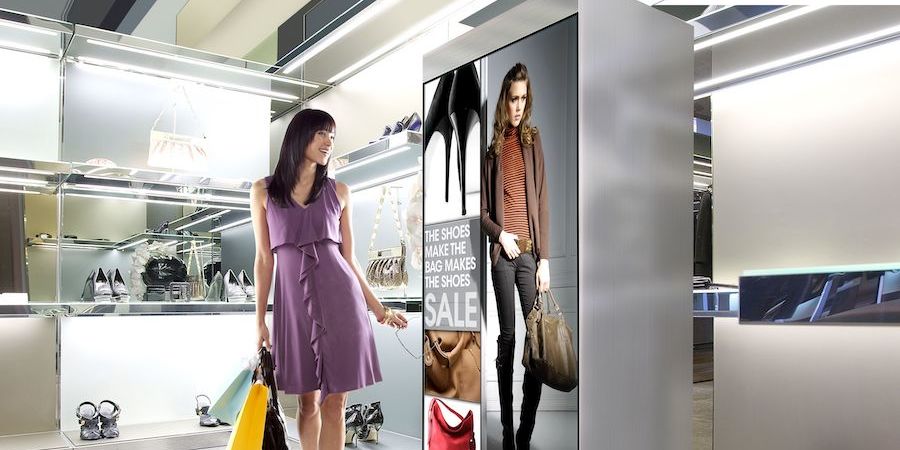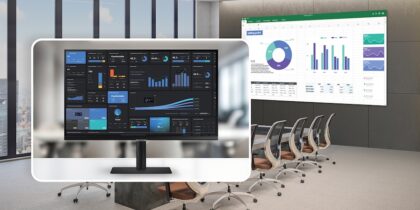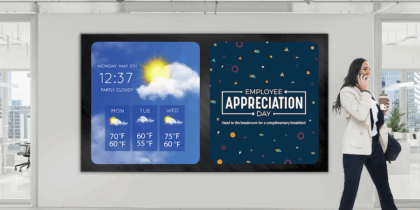Technology is giving retailers and brands a better understanding of how consumers shop and how stores operate, which enables them to apply solutions to optimize selling opportunities.
In-store analytics technologies — using sensors and software — are providing rich insights into how shoppers move around and interact with stores. This includes which sections of the store they visit, how long they stay in a particular area, what they look at and how their behavior translates to sales and store operations.
Retailers who have a better handle on consumer profiles and actions are in an optimal position to tune their stores to the typical customer journey and start personalizing shopper experiences.
Digital signage and interactive display technology play a big role throughout the customer journey, from messaging that pulls shoppers through doors to encouragements at checkout to join loyalty programs and become regular shoppers.
The Buyer’s Journey
Every shopper has a journey. The path starts with the awareness of the store and the goods and services the store provides. Shoppers then transition to the discovery and consideration phase in which they interact with the store or brand. Finally, their journey finishes with a transaction at the checkout counter.
The dynamics of that journey have changed over the last few years because of online retailing and, more broadly, the internet. Almost nine in 10 shoppers do online research on products before they buy, so they tend to arrive at stores more knowledgeable than ever.
That pre-shopping acumen — researching online before going to stores — is changing the way retailers need to deliver on the customer experience. Most shoppers today are turned off by retailers who have not adjusted to today’s shopping trends.
Consumers feel empowered by digital information and value the ability to do in advance or on-the-spot product research using their smartphones or other mobile devices Because of the influx of on-demand product information, consumers may feel they know more about the product than store associates serving them
While consumers are looking to the internet for product information, they still see the value in traditional brick and mortar, but only if they can learn, experience and receive solid advice. They don’t want store experiences that center around being sold an item.
Awareness and Attraction
The average customer journey starts outside and it is the job of retailers have to compel their customers to walk in the door.
Attracting the consumer and driving awareness of what the store offers starts in the entryway — whether the physical façade of the store, the identifying signage or the windows that attract them. First impressions are important, so those entryways are increasingly adorned with display technology to “wow” shoppers and set the tone for what’s to come.
Two different display technologies do the work to capture attention and build interest:
1. Outdoor-grade, direct view LED displays are replacing conventional store signs — creating large-format exterior walls or headers that drive the brand and suggest this is an interesting place worth visiting.
2. Super-bright outdoor-rated LCD displays mounted in standalone totems or embedded in a store façade can cut through even direct midday sun and beckon people inside with promotions and calls to action. New Samsung dual-sided displays can be placed in shop windows to reach out to passing shoppers on one side and relay different messages on the rear panel to people who come inside.
Informational Messaging
Once shoppers have been drawn inside, they shift quickly to consideration mode, weighing options on where to start, where to go and steadily scanning shelves, tables and messaging.
Digital displays positioned around retail environments have the ability to broadcast messages or offer one-to-one information and interactivity. Well-positioned displays, running the right content, can have a dramatic, positive impact on purchase basket size and impulse buying.
Different types of displays reach shoppers in different ways:
- Digital posters and interactive displays at entries and key decision points help direct people. They can offer navigation, product research and make shoppers aware of special offers or events.
- Larger flat panel displays — standalone or in video wall arrays — run branding and ambient materials that set the tone for the store. Custom content ranges from curated video of a fashion brand’s runway shows to local content celebrating a city, neighborhood or culture. Both LCD and fine pitch direct view LED are being used for these applications.
- Flagship and other major locations for retail brands are increasingly making large-format LED central to store designs as huge feature walls that create visual excitement and drive experience.
- At the opposite end, smaller conventional and touchscreen-equipped displays are being positioned by retailers at merchandising positions, enabling consumers to do self-guided learning for products like electronics that trigger many questions or beauty brands with seemingly endless variations.
Additional to the technology Samsung offers, there’s also a behind the scenes capability to make the most out of data. Samsung’s video analytics can dive deep into the buyer’s journey and unlock a total store view of how consumers move and decide, which can then help businesses lean into personalized marketing messages.
Checking Out
As consumers take the last steps of their shopper journey, displays are still a crucial element of the experience. The checkout and service counter areas of stores use displays for brand reinforcement, to drive loyalty cards and programs, and provide advance notice on upcoming promotions.
They also have strong operational value. Good content on displays can substantially reduce perceptions of wait times in checkout lines and minimize the number of shoppers who abandon lengthy lines and leave empty-handed. Abandoned lines mean lost sales and customers who may not return.
On a practical level, busy stores are using displays for queue management, directing people in common line-ups to available cashiers.
Importance of Signage
So why should businesses make signage central to the shopper journey? It makes a difference.
Research suggests, among many things, that 80 percent of shoppers have entered a store because they saw something on digital signage. It’s logical that consumers react to what they see, and while other mediums like broadcast and print might be the start of awareness, nothing is more impactful than messaging done right in the store.
Traditional in-store marketing tools like print will always have a role in retail, but digital gives retailers the tools they need to compete with other brick and mortar and online stores. It’s never been more important to be nimble, relevant and quick to adjust. When your marketing message can be changed on displays in seconds — instead of days or weeks with print — that’s a game-changer.
Learn more about optimizing the shopper’s journey with digital signage in this free white paper, or see how one family business transformed their stores with dual-sided displays in this short video.








